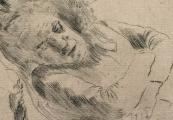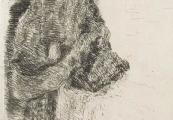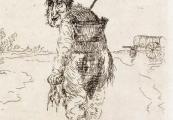This archived website ‘James Ensor. An online museum.’ is temporarily not being updated. Certain functionality (e.g. specific searches in the collection) may no longer be available. News updates about James Ensor will appear on vlaamsekunstcollectie.be. Questions about this website? Please contact us at info@vlaamsekunstcollectie.be.
Portraits: Common People
With his representation of common people from the harbour town of Ostend, James Ensor linked up with a theme which he had also dealt with at the start of his career, around 1882, in a number of paintings and charcoal drawings. Ensor shared this inquisitiveness with his friend Willy Finch, with whom he often wandered along the working-class areas of Ostend. The artist openly sympathized with the poor, the homeless and the tramps, who were withdrawn from the eyes of the tourists as much as possible by the local government. The result, an example of which is the painting The Ferryman (Antwerp, Royal Museum of Fine Arts, inv. 2174), are unbiased, slightly exaggerated portraits, in which, contrary to social-realism, there is absolutely no idealization. Whilst these works show a sort of compassion, Ensor's view becomes critical and merciless in the middle of the 1890's, as is illustrated by the etchings Ill Mop near the Stove and The Drain Cleaner. Judging from the space in which his models were posing, it is fair to say that Ensor invited them to his workshop to produce the portrait there.









